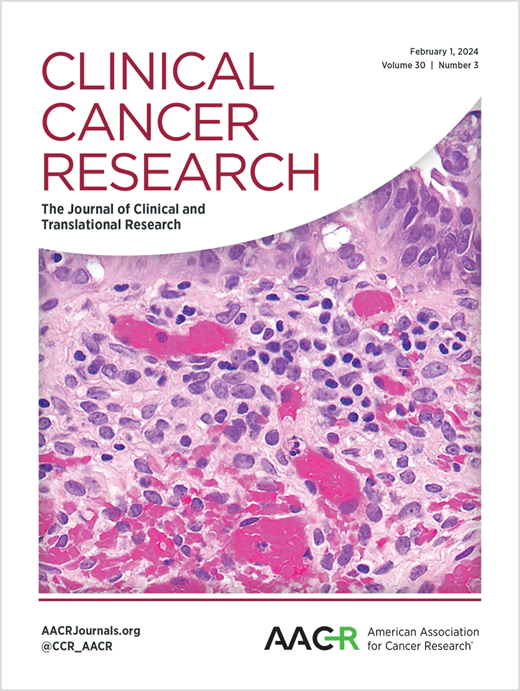术前消融放疗与胰腺癌的局部控制和免疫反应有关
IF 10
1区 医学
Q1 ONCOLOGY
引用次数: 0
摘要
目的:比较胰腺癌新辅助化疗合并和不合并消融放疗(SAbR)后手术患者的预后和分子特征。Insight可以阐明SAbR的益处,并为未来的治疗方案提供分子指导。实验设计:这项单机构、三级医疗学术中心队列研究纳入了2012-2023年间诊断为胰腺癌的所有接受新辅助化疗的患者,无论是否伴有SAbR。我们比较了治疗反应,进行了患者匹配,并进行了Cox模型来确定组间的差异。我们使用RNA测序来评估分子反应,以确定sabr诱导的生物学差异。结果:133例化疗患者和48例化疗+ SAbR患者中,分别有29例和14例患者获得RNA测序。尽管基线疾病更晚期,但SAbR组表现出更好的治疗后病理和相似的总生存率(HR = 0.97, 95% CI = 0.58-1.60, P = 0.9)。患者匹配显示SAbR改善了局部无复发生存率(HR = 0.24, 95% CI = 0.07-0.88, P = 0.009)。动脉受累增加单纯化疗的局部衰竭风险(HR = 3.37, 95% CI = 1.74-6.54, P <;.001), SAbR显著降低(HR = 0.28;95% ci = 0.12-0.68;P = .005)。基因集富集分析显示免疫激活,CD8和NK/NKT细胞特征与局部控制相关,Treg特征与较差控制相关。结论:新佐剂SAbR与改善病理结果、增强局部控制和维持生存有关,同时诱导明显的免疫反应。需要充分的研究来阐明它的临床益处。本文章由计算机程序翻译,如有差异,请以英文原文为准。
Presurgical ablative radiation is associated with local control and immune response in pancreatic cancer
Purpose: To compare outcomes and molecular characteristics of patients who had surgery after neoadjuvant chemotherapy, with and without ablative radiotherapy (SAbR) for pancreas cancer. Insight could clarify the benefits of SAbR and provide molecular guidance for future therapeutic regimens. Experimental Design: This single-institution, tertiary care academic center cohort study included all patients diagnosed with pancreatic cancer between 2012–2023 treated with neoadjuvant chemotherapy, with or without SAbR. We compared therapeutic responses, performed patient matching, and conducted Cox modeling to identify differences between groups. We assessed molecular response using RNA sequencing to identify SAbR-induced biologic differences. Results: Among 133 patients receiving chemotherapy and 48 receiving chemotherapy + SAbR, RNA sequencing was available for 29 and 14 patients, respectively. Despite more advanced baseline disease, the SAbR group showed better post-treatment pathology and similar overall survival (HR = 0.97, 95% CI = 0.58–1.60, P = .9). Patient matching indicated that SAbR improved locoregional recurrence-free survival (HR = 0.24, 95% CI = 0.07–0.88, P = .009). Arterial involvement raised local failure risk with chemotherapy alone (HR = 3.37, 95% CI = 1.74–6.54, P < .001), which was significantly reduced with SAbR (HR = 0.28; 95% CI = 0.12–0.68; P = .005). Gene set enrichment analysis showed immune activation, with CD8 and NK/NKT cell signatures associated with local control and Treg signatures associated with worse control. Conclusion: Neoadjuvant SAbR is associated with improved pathological outcomes, enhanced local control, and maintained survival while inducing a distinct immune response. Well-powered studies are needed to clarify its clinical benefits.
求助全文
通过发布文献求助,成功后即可免费获取论文全文。
去求助
来源期刊

Clinical Cancer Research
医学-肿瘤学
CiteScore
20.10
自引率
1.70%
发文量
1207
审稿时长
2.1 months
期刊介绍:
Clinical Cancer Research is a journal focusing on groundbreaking research in cancer, specifically in the areas where the laboratory and the clinic intersect. Our primary interest lies in clinical trials that investigate novel treatments, accompanied by research on pharmacology, molecular alterations, and biomarkers that can predict response or resistance to these treatments. Furthermore, we prioritize laboratory and animal studies that explore new drugs and targeted agents with the potential to advance to clinical trials. We also encourage research on targetable mechanisms of cancer development, progression, and metastasis.
 求助内容:
求助内容: 应助结果提醒方式:
应助结果提醒方式:


